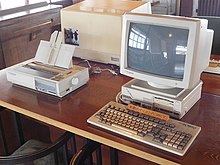
Back حاسوب إن إي سي - 9801 Arabic بى سى 98 ARZ NEC PC-9801 Czech PC-98 German NEC PC-9801 Spanish انئیسی پیسی-۹۸۰۱ Persian NEC PC-9801 Finnish PC-98 French PC-98 ID NEC PC-9801 Italian
 PC-9801UV11 (1988) | |
| Manufacturer | Nippon Electric (NEC) |
|---|---|
| Type | Personal computer |
| Release date | October 1982 (PC-9801) November 1992 (PC-9821) |
| Introductory price | ¥298,000 |
| Discontinued | September 30, 2003[1] |
| Units shipped | 18.3 million[2] |
| Operating system | N88-BASIC(86), CP/M-86, MS-DOS, Windows, OS/2, PC-UX |
| CPU | 8086 @ 5 MHz and higher |
| Memory | 128 kilobytes and higher |
| Display | µPD7220, 640 × 400 with 16 colors (from 4096) |
| Sound | Beeper, YM2203 (some models) |
| Power | 100 VAC (desktop) |
| Predecessor | PC-8800 series |
| Language | Japanese language |
The PC-9800 series (Japanese: PC-9800シリーズ, Hepburn: Pī Shī Kyūsen Happyaku Shirīzu), commonly shortened to PC-98 or 98 (キューハチ, Kyū-hachi),[3] is a lineup of Japanese 16-bit and 32-bit personal computers manufactured by NEC from 1982 to 2000. The platform established NEC's dominance in the Japanese personal computer market, and, by 1999, more than 18 million units had been sold.[4] While NEC did not market these specific machines in the West, it sold the NEC APC series, which had similar hardware to early PC-98 models.
The PC-98 was initially released as a business-oriented personal computer which had backward compatibility with the successful PC-8800 series. The range of the series was expanded, and in the 1990s it was used in a variety of industry fields including education and hobbies. NEC succeeded in attracting third-party suppliers and a wide range of users, and the PC-98 dominated the Japanese PC market with more than 60% market share by 1991. IBM clones lacked sufficient graphics capabilities to easily handle Japan's multiple writing systems, in particular kanji with its thousands of characters. In addition, Japanese computer manufacturers marketed personal computers that were based on each proprietary architecture for the domestic market. Global PC manufacturers, with the exception of Apple, had failed to overcome the language barrier, and the Japanese PC market was isolated from the global market.[5]
By 1990, average CPUs and graphics capabilities were sufficiently improved. The DOS/V operating system enabled IBM clones to display Japanese text by using a software font only, giving a chance for global PC manufacturers to enter the Japanese PC market. The PC-98 is a non-IBM compatible x86-based computer and is thus capable of running ported (and localized) versions of MS-DOS and Microsoft Windows. However, as Windows spread, software developers no longer had to code their software separately for each specific platform, and the PC-98 became regarded as one of the Windows-based machines like other IBM clones. The PC-98 adopted non-proprietary parts developed for IBM clones to reduce manufacturing costs. Due to the popularity of Windows 95, the demand for the PC-98 on which legacy applications depend had declined. In 1997, NEC abandoned compatibility with the PC-98 and released the PC98-NX series based on the PC System Design Guide.[6]
- ^ PC-9800シリーズ受注終了のお知らせ [PC-9800 Series Discontinuation Notification] (in Japanese). NEC. 7 August 2003. Retrieved 7 June 2016.
- ^ Cite error: The named reference
ozawa_2004was invoked but never defined (see the help page). - ^ 用語解説辞典【キューハチ】. NTT PC Communications. Archived from the original on 2015-06-28. Retrieved 2019-03-24.
- ^ "Computing Japan". Computing Japan. 54–59. LINC Japan: 18. 1999. Retrieved 6 February 2012.
...its venerable PC 9800 series, which has sold more than 18 million units over the years, and is the reason why NEC has been the number one PC vendor in Japan for as long as anyone can remember.
- ^ Cite error: The named reference
:2was invoked but never defined (see the help page). - ^ SE編集部 (2010). "4. DOS/VとWindowsの時代". 僕らのパソコン30年史 (in Japanese). Shōeisha. pp. 95–115. ISBN 978-4-7981-2189-5.
© MMXXIII Rich X Search. We shall prevail. All rights reserved. Rich X Search